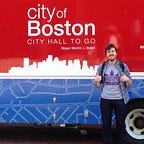Co-Creating with Cities: Announcing the Stae Civic Data Sandbox
At Stae we believe that civic data is a key public asset that can be put to work to improve urban communities for everyone. We also believe that democratically accountable institutions — namely our local governments — need to play a leading role to make that happen.
Empowering local governments is exactly what we had in mind when we first started building Stae’s municipal.systems platform, and it’s why, from the start, we’ve worked alongside city officials — from department staff delivering services to citywide innovation officers managing enterprise data — to develop and iterate on our tools.
We want to continue making Stae both for and with city halls and other public agencies, and that’s why we are excited to announce five pilot projects via a new collaborative program we’re calling Civic Data Sandbox.
The Sandbox is a place where cities can work with the Stae team to explore how new approaches to data management might help improve workflow and address urban challenges. Critical to this work is the idea that we are not bringing a “solution,” but rather starting with simple questions like “how might civic data help achieve your community’s goals?” and working together from there. By taking an inquiry-based approach, our hope is that we can continuously evolve our product from a city-centered (rather than tech-centered) perspective.
So, without further ado, here’s our first cohort of Sandbox cities! We’re excited for each of these projects to achieve real results for our local government partners, and we’ll be sharing our learnings along the way.
San Francisco, CA
How might we make data on public life more public?
Stae will build on our previous work with Gehl Institute by helping the San Francisco Planning Department standardize and share their geodatabase of data collected on public life. We will iterate on ways the city and the public can use this data to tell compelling stories about the successes and challenges of the San Francisco’s public spaces — with the ultimate goal of helping SF Planning use data to inform public space policy and design going forward.
Louisville, KY
How might mobility data inform traffic engineering and transportation planning?
We’ll be working with the The Office of Performance Improvement & Innovation to explore how we can build out a mobility data warehouse using both data from the city as well as from external mobility partners and operators. Possible applications include streamlined traffic management, Vision Zero public safety improvements for bicyclists and pedestrians, and data-driven transportation planning to support multimodal streets.
Syracuse, NY
How might city hall use smart sensors to improve city intelligence and public transparency?
As Syracuse prepares to purchase its street light system from National Grid, we’ll be working with the Innovation Team (“i-team”) to explore how the city might unlock the potential of this new smart sensors network. We’ll be experimenting with real-time monitoring of GPS and other IoT sensors to provide better intelligence to city staff and greater transparency to the public.
Greensboro, NC
How might cities manage and evaluate new, shared mobility services?
The City of Greensboro has developed a “Pilot Standup Electric Scooter Share Program” that will run through the summer, and multiple scooter operators—including both Bird and Lime—are participating. Stae is excited to be working with the Greensboro Information Technology Department as well as with the city’s Engineering Division to support this effort. By helping the city leverage scooter data and other relevant transportation data, the goal is to support both day-to-day program management and evaluate the pilot’s impact.
Guilford County, NC
How might a county government collaborate with regional and external partners to collect community indicators?
Finally, we are excited to be working with a county government in addition to four cities. Guilford County realizes that data for public good can come from a variety of sources—the public sector, private sector, and non-profits. The county is involved in a number of civic research and service delivery initiatives, such as the Greater Greensboro Community Indicators Project, and is interested in incorporating community data sources—particularly from non-profit partners—into its work. To explore that idea, we’ll be helping Guilford take a “community data census” and experiment with ways to integrate with new data partners.
We’ll be sharing progress and insights from our first cohort of Sandbox cities as they evolve this spring on the City as a Service blog. If you’re interested in applying to be part of the next cohort later in 2019, please reach out.
